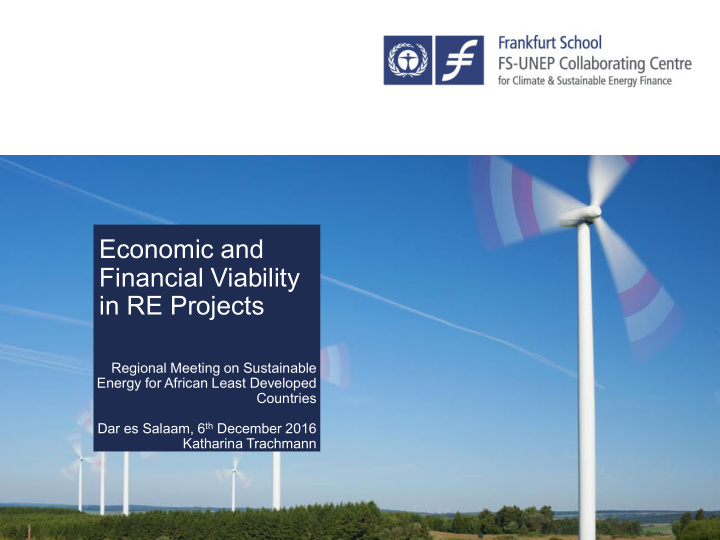



Economic and Financial Viability in RE Projects Regional Meeting on Sustainable Energy for African Least Developed Countries Dar es Salaam, 6 th December 2016 Katharina Trachmann
The Centre‘s Approach The Centre combines research with project implementation to foster a dialogue between the private and public sector A strategic collaboration between the United Nations Environment Programme and Frankfurt School, the Centre is supported by the German Federal Ministry for the Environment. Project design Acting as UNEP’s main knowledge hub for sustainable energy and climate finance, the Project Centre carries out research with an Research implementation orientation towards practical application: Implementing findings and instruments in Policy advice the field and thereby functioning as think and do tank Crowding in new investors, in particular from the private sector Structuring and combining of innovative financing instruments 2
Project Preparation: Business Plan Development The “ideal financing process” Lenders are approached with a stable business plan Equity is committed The Risks are allocated to the party best able to manage them ideal PPA is signed (or at least in the final phase of negotiation) and the project has all required permits world… Other key documents available for review: Connection Agreement, Engineering, Procurement and Construction Contract, Operation and Maintenance Agreement and the Government Support and Consent Agreement Equity is not fully committed and the financing structure still highly … vs indicative reality in Permitting process is ongoing and the project initiator cannot provide a less draft PPA mature The role of the lender is often a broader and more active one involving some „coaching“ of the initiator markets! Also, commercial lenders are often involved at an earlier stage in the process 3 Risks are allocated in an inefficient manner
Project Preparation: Business Plan Development Varying objectives of RE project stakeholders (non-exhaustive) Lender Equity Investor Utility/Regulator: • Appropriate risk/return • Equity IRR • Decreasing average profile • Appropriate risk/return generation cost • Balance sheet profile • Diversification of protection • Long-term technologies and • ALM guidelines involvement energy mix • Business • Closing the demand- creation/portfolio supply gap (if any) diversification • Macroeconomic viability of the project Developer Insuring a viable business case by creating a win-win situation for all stakeholders 4
Definition of a Viable Business Case Financial vs economic viability of RE Economic viability Financial viability Does the project make sense from a Does the project offer an attractive societal /macroeconomic perspective? investment opportunity for a private sector investor (project perspective only)? • Average generation costs over the next +/- 20yrs? Based on power purchase agreement (PPA) terms • Contribution to ‚ideal‘ energy mix? Ability to service debt • Additional generation capacity required? Ability to pay dividends (EIRR) • Diversification of technologies Payback periods • Hidden subsidies and externalities Considers risk profile of investment taken into account? 5
Financial vs Economic Viability of RE Balancing private and pubic sector needs Generation mix, fuel costs, demand Regulator growth … Economic and financial viability can differ High Economic viability driven by Economic Financial external factors viability viability Financial viability for RE should be driven by regulatory framework Low Attractiveness of Attractiveness of projects for the projects for an society investor 6
Economic & Financial Viability of RE Don’t tip the scales Sustainability High Sustainability Sustainability E E F F E F Low Many RE projects Less RE projects Least cost development energy sector strategy Inefficiency 7
Economic & Financial Viability of RE Finding the sweet spot for all – price setting Financial viability Economic viability How much you have to How much you should pay at a max. to pay at a min. to attract stick to the least cost development path private sector activity Steering the volume & speed of IPP activity ? Go/No-Go Adjustment for other advantages/disadvantages. (base load, tech diversification,…) Average Additional Economic Art of price LCOE generation cost generation viability setting IPP (of new capacity benchmark? capacity) in the required? grid (next 20 yrs) 8
Utilities and their quest to remain in control Africa’s historical struggles – total cost and tariff revenues 9
Key Takeaways Efficiency in the energy sector is reached if financial viability reflects economic viability Regulation is key to create a level playing field and align economic and financial viability Regulator to monitor economic viability and define financial viability From the start of project development, responsible developers should take the necessity of balancing both economic and financial viability into consideration 10
Back-up
Business Plan Preparation Stages 12
Business Plan Preparation Stages 13
Utilities and their quest to remain in control Africa’s historical struggles – total cost and tariff revenues 14
Business Plan Preparation Concept Calculating the levelised cost of energy (LCOE) can provide a useful basis for comparing the generation costs of conventional energy sources and those of renewable energy Economic assessment that includes all the costs over a plant’s lifetime: Investment Operations and Financing and depreciation costs maintenance LCOE (initial capital + (debt and equity) (+ fuel cost for development conventional) costs) NPV calculation performed and solved in such a way that the project’s NPV is zero for the value of the LCOE chosen. This means that the LCOE is the minimum price at which energy must be sold for an energy project to break even Downside: Calculation based on the assumption that the timing and flexibility of electricity generation is irrelevant 15
LEVELISED COST OF ELECTRICITY – COMPONENTS AND DRIVERS 16 Source: GET FiT Plus, DBCCA, 2011
Recommend
More recommend